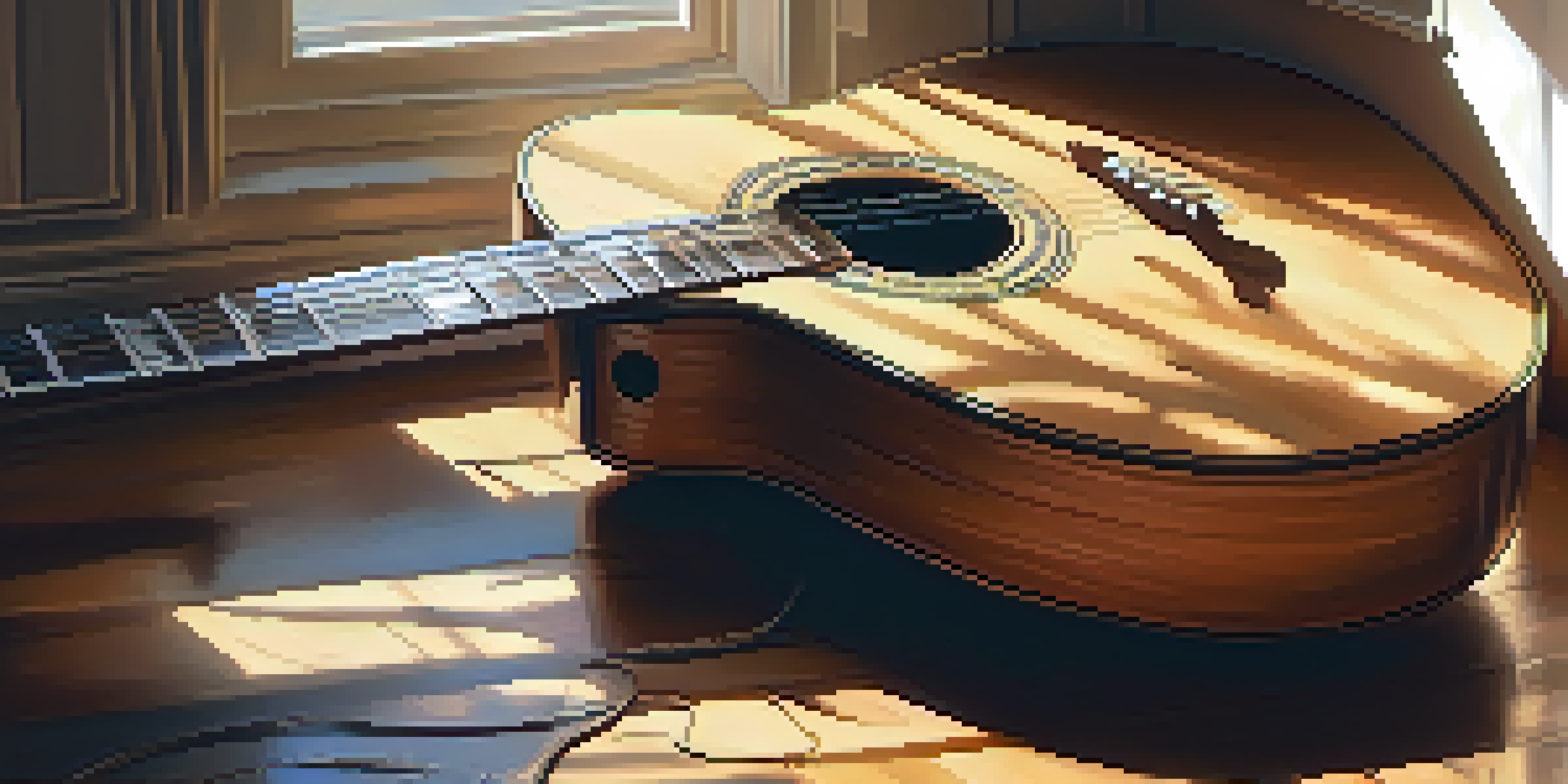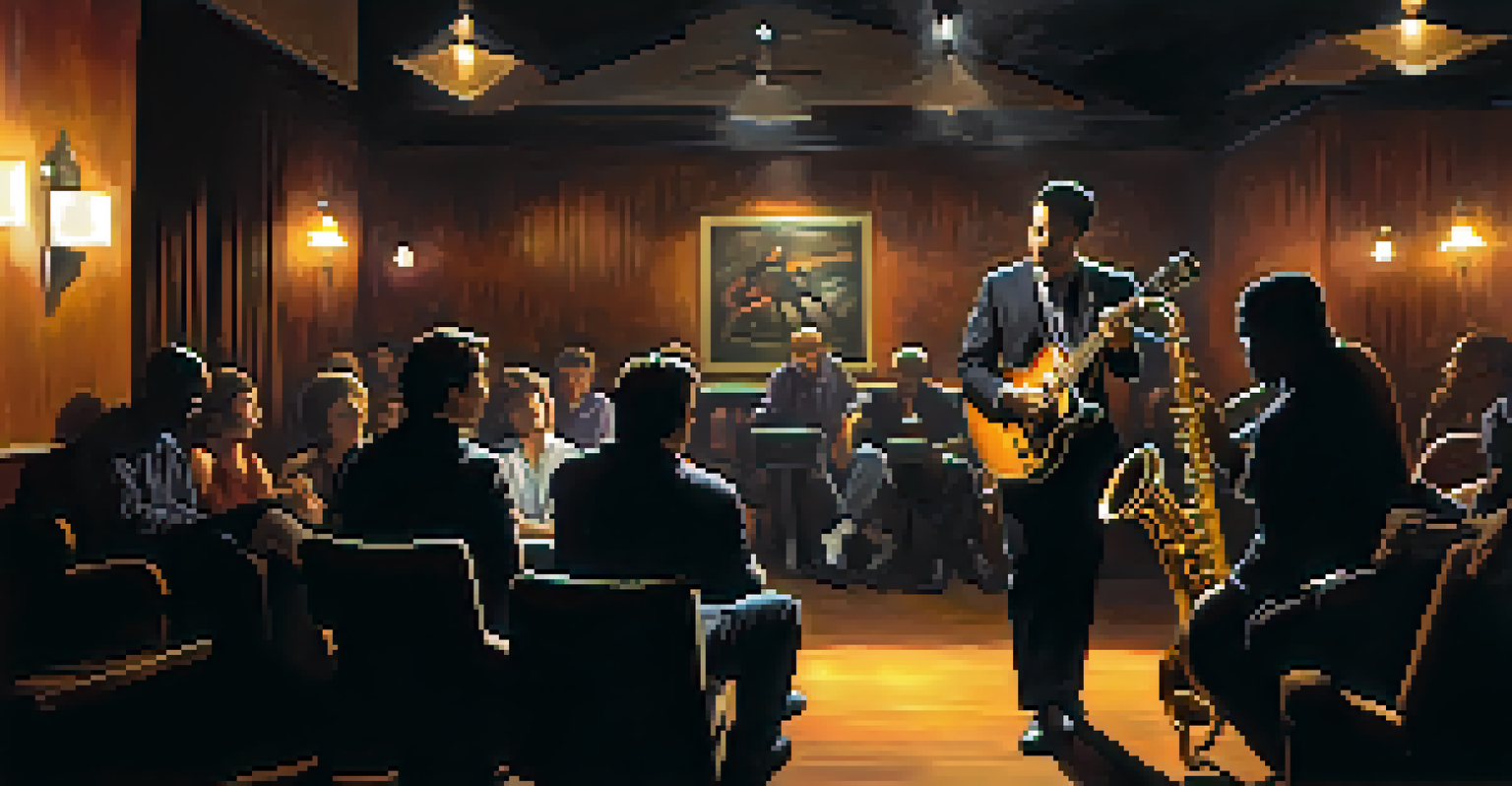Guitar Genres: From Blues to Metal and Their Popularity

Understanding the Roots: The Birth of Guitar Genres
Guitar music has a rich history that dates back centuries, with each genre carving out its unique identity. From the soulful sounds of early folk music to the electrifying riffs of rock, the guitar has always played a central role. Understanding these roots helps us appreciate the evolution of guitar genres and their cultural significance.
The guitar is a remarkable instrument that can express the deepest emotions and convey stories in a way that words often cannot.
The journey begins with genres like blues, which emerged from African American communities in the Deep South. It combines elements of African musical traditions, spirituals, and folk songs, creating a heartfelt expression of life's struggles. As blues evolved, it influenced countless other genres, solidifying its place as a foundational style.
As we delve deeper into the world of guitar genres, we see how they reflect societal changes and musical innovations. Each genre tells a story, from the raw emotion of blues to the high-energy performances of metal, showcasing the versatility and impact of the guitar.
The Soulful Sounds of Blues: A Deep Dive
Blues music, often characterized by its expressive guitar solos and poignant lyrics, captures the essence of human emotion. It’s a genre that resonates with listeners, allowing them to connect with the struggles and triumphs expressed in the music. Famous guitarists like B.B. King and Eric Clapton have brought blues to the forefront, inspiring generations.

The 12-bar blues progression is a hallmark of the genre, creating a familiar yet powerful structure that musicians and audiences alike adore. This format allows for improvisation, a key element that gives blues its raw and spontaneous feel. It’s not just about the notes played, but the feelings conveyed through each strum and bend.
Guitar Genres Reflect Cultural Change
Each guitar genre, from blues to metal, embodies the societal changes and musical innovations of its time.
As blues has evolved, it has given birth to sub-genres like Chicago blues and Delta blues, each with distinct characteristics. The genre has also influenced rock, jazz, and even country music, proving its lasting impact on the musical landscape.
Rock: The Evolution of Guitar Power
Rock music, emerging in the 1950s, harnessed the electric guitar's power, creating an energetic sound that captured the youth's spirit. With iconic figures like Jimi Hendrix and Led Zeppelin, rock became synonymous with rebellion and freedom, pushing musical boundaries. The guitar solos in rock are often seen as a rite of passage for aspiring musicians.
Music is a world within itself; it’s a world of the higher powers, it’s a world of the guitar.
One of the defining traits of rock is its variety, encompassing sub-genres such as classic rock, punk rock, and alternative rock. Each style offers a different flavor and showcases the guitar's versatility, from the raw simplicity of punk to the intricate solos of progressive rock. This diversity keeps rock music fresh and continuously evolving.
The popularity of rock has seen ups and downs over the decades, yet its influence remains undeniable. Today, rock continues to inspire new artists, blending with contemporary styles to create innovative sounds that resonate with both old and new fans.
Metal: The Bold and Powerful Guitar Legacy
Metal music, known for its heavy riffs and intense energy, emerged in the late 1960s and has since developed into a powerful genre. Bands like Black Sabbath and Metallica have defined its sound, characterized by distorted guitars and aggressive rhythms. Metal's popularity can be attributed to its ability to evoke strong emotions and a sense of empowerment.
Sub-genres of metal, such as thrash, death, and power metal, offer a wide range of sounds and styles, appealing to diverse audiences. Each sub-genre brings unique elements, from the speed of thrash metal to the melodic harmonies of power metal, showcasing the guitar's adaptability. This variety keeps the genre dynamic and continuously evolving.
Blues: The Heart of Guitar Music
Blues music, with its expressive solos and poignant lyrics, serves as a foundational genre that has influenced many others.
The metal community is known for its passionate fanbase, with concerts often resembling a cathartic release for attendees. The guitar plays a pivotal role in this experience, with solos and riffs that ignite excitement and energy, solidifying metal's place in the musical landscape.
Folk and Acoustic: The Gentle Guitar Strums
Folk music celebrates storytelling, often accompanied by simple yet beautiful acoustic guitar melodies. This genre has roots in various cultures and traditions, making it incredibly diverse. Artists like Bob Dylan and Joan Baez have used the guitar to convey powerful messages about social change and personal experiences, making folk music deeply relatable.
The acoustic guitar's warm sound lends itself to intimate performances, inviting listeners to connect on a personal level. The fingerpicking techniques often used in folk create intricate patterns that enhance the storytelling aspect of the music. This style showcases the guitar's ability to evoke emotion without the need for heavy production.
Folk music continues to thrive today, with new artists breathing life into traditional sounds. The blend of modern influences with classic folk elements keeps the genre fresh and relevant, appealing to both longtime fans and new listeners drawn to its sincerity.
Jazz: The Guitar's Sophisticated Side
Jazz is a genre where improvisation and creativity reign supreme, and the guitar plays a crucial role in this artistic expression. Artists like Django Reinhardt and Wes Montgomery have paved the way for guitarists in jazz, showcasing the instrument's melodic and harmonic capabilities. The intricate chord progressions and rhythms in jazz offer a playground for guitarists to experiment.
Jazz guitarists often use techniques like chord-melody playing and swing rhythms to create a unique sound. The interplay between the guitar and other instruments in a jazz ensemble adds depth and texture to the music. This collaborative approach fosters a sense of spontaneity, making each performance a one-of-a-kind experience.
Future: Blending Guitar Styles
The future of guitar music lies in the fusion of various styles, creating innovative sounds that resonate with diverse audiences.
While jazz may not have the mass appeal of rock or pop, its influence on modern music is profound. Elements of jazz can be found in various genres, proving the guitar's versatility and the richness of its contributions to the musical world.
The Future of Guitar Genres: Blending Styles
As music evolves, so do guitar genres, often blending elements from various styles to create something entirely new. Artists today are experimenting with electronic music, hip-hop, and even world music, incorporating guitar in innovative ways. This fusion not only expands the guitar's reach but also introduces new audiences to its timeless appeal.
The rise of technology has made it easier for musicians to explore and share their unique sounds, leading to a vibrant and diverse musical landscape. Platforms like social media and streaming services allow aspiring guitarists to showcase their work, often resulting in unexpected collaborations across genres. This accessibility encourages creativity and experimentation.

As we look to the future, the guitar will undoubtedly continue to adapt and inspire. Whether through traditional forms or modern blends, the guitar remains a powerful instrument that connects people and expresses the human experience in countless ways.